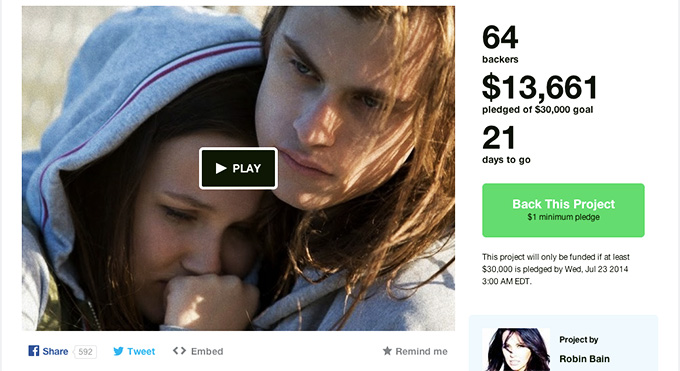By providing your information, you agree to our Terms of Use and our Privacy Policy. We use vendors that may also process your information to help provide our services. This site is protected by reCAPTCHA Enterprise and the Google Privacy Policy and Terms of Service apply.
Here’s How to Crowdfund Successfully: With Expert Advice from Kickstarter, Indiegogo and Seed&Spark

With the democratization of filmmaking in the digital age comes an over-saturated virtual marketplace; everyone (and probably their mom) is asking for your money to fund their project. So how do you circumvent a “Portlandia” parody and build a meaningful —and successful— crowdfunding campaign?
We asked the experts. Kickstarter, Indiegogo, and Seed&Spark have hosted hundreds of thousands of campaigns, from million-dollar successes to unfunded failures. While crowdfunding is not an exact science, there are fundamental variables that will bolster your ability to get your project funded. Last week, Indiewire and Craft Truck co-hosted a Q&A Google Hangout featuring representatives from these seasoned crowdfunding platforms. At the end of the Q&A, we opened up the discussion to the filmmaking community. Here are the essential highlights from the conversation. Follow these guidelines and you’ll have a statistical advantage in funding your film.
The Pitch Video
Emily Best (Seed&Spark): Have a script. Get feedback on your video. You have fifteen seconds before people are going to decide whether or not to stop watching. That fifteen seconds should be spent reaching your audience, not your mom or your friend. We see a huge number of people who sit down and say, “Hi. My name is John. I am making a thriller.” Already, the audience for thriller is gone. I was just working with a campaign for a thriller-based series, and I watched their pitch video, and the first fifteen seconds were shot like a thriller. I told them, “Good job, guys!” Your first fifteen seconds should match the tone of your film.
Craig Ensler (Kickstarter): Have a pitch video. You’re doing a film project. Campaigns with videos succeed far more often than campaigns without videos. Have fun with it. The people who do great videos are going to do great projects. We recommend you keep it to around two minutes. Most importantly, share your enthusiasm. You’re not going out and asking for money — you’re going out and telling them what they’re getting, why they should be backing you. Your enthusiasm will come through. There was one video where the first try was a bit dry, so we told them it was a bit dry, then they came back with a second video and it was awesome. We were like, “What did you do between the first and second video?” And the person was like, “Well, I had a couple glasses of wine.”
READ MORE: Filmmakers Crowdfund for Distribution and Marketing
Mark Hofstatter (Indiegogo): People forget to make an emotional connection [with their videos]. It’s sharing your passion. To that end, some people make the mistake of having a trailer for a pitch video. A trailer doesn’t evoke an emotional response. It doesn’t ask you to do anything. It says, “Here’s this cool thing,” and that’s it. You’re trying to get people to participate in what you’re doing. So don’t have a trailer, have a pitch video. As much as you would pitch any other financier, tell them in a succinct amount of time who you are, what you’re doing, why you’re doing it, how you’re going to do it, and what they can do. Don’t forget to say ‘thank you.’

Rewards and Incentives
Ensler: The best reward that you could ever give is a copy of the thing that you’re doing. So in the case of a film, you want to be able to give a digital download, a DVD, the premiere ticket, some way to see the thing. Tier-wise, you always want to have a lower tier in the $1-$5 range just so that somebody can give their moral and social media support. They’ll tweet it out even if it was for a dollar. $25 is the most popular donation in terms of the number of people on Kickstarter that will choose that monetary value. So always have something in the $25 range. We consistently see the most money comes at the $70 dollar range. So that means that there are fewer people backing at $70, but because they’re backing more money, you’re going to get the most money at that tier. So have something great at $70. We always say have some really big tiers—couple hundred, a thousand, depending on what it is. Give experiential rewards. Things that reward someone with some meaningful interaction, whether it’s being an extra on set, getting a producer credit, or that you’ll read their script and give them feedback. Limited editions, special things, one-night-only events…. Then you’re truly rewarding a backer for getting in early and helping a project versus someone who might be able to buy the DVD 6 months or a year from now. Think about your friends. Would your friends think your rewards were cool? If the answer is yes, then your rewards are good. If your answer is no, then you might want to rethink your rewards.
Best: Make them personal, visual, and shareable. For example, a young man made a short film called “Time Signature.” It’s about time travel. When you contributed to his campaign, at the $25 and under, he wrote to you and said, “What point in time would you like to visit?” So I was being a jerk and said, “I want to be at the signing of the Magna Carta at the founding of the government.” And in 15 minutes, he’d found a picture of me, Photoshopped me into it, and tweeted it. It said, “We found Emily Best at the signing of the Magna Carta. Where will we find you?” and gave a link to the project. All the things that are awesome about this: It cost him nothing. It made me trust him immediately as an artist. I shared it everywhere, and other people, when they discovered that I had the same haircut as a 14th century friar, also shared it everywhere. He created something that, as a thank you to me, could be more publicity for his project. It’s also thinking about when you fulfill rewards immediately versus when the project is finished. He was taking a risk there that maybe the project wouldn’t be successful, but he was making sure to say a very personal, visual, and shareable thank you to all of his backers immediately. You want to think of rewards that deepen engagement versus proliferate stuff. In the film space, we are filmmakers. We are not manufacturers.
READ MORE: 10 Great Social Media Tips for Filmmakers (Especially When Crowdfunding)
Hofstatter: People contribute to a campaign for one of three reasons. We call it the “3 P’s.” The person, the project, or the perk. If it’s Alex Gibney executive producing your film, offer up a class on how to be a doc filmmaker. There’s a filmmaker in East Asia right now crowdfunding her first feature film, and one of the perks she’s offering up at a higher end is a tour of Laos. Be fun and inventive. Have someone write you a song or a poem on your ukelele. A unique one-on-one experience. Whatever makes you have more of a relationship with the filmmaker, the film, makes you feel a part of the process, whatever makes you want to shout from the rooftops, “This is amazing, you should be a part of this process!”

The Fundraising Goal
Best: Raise enough money to advance the project exactly how much you’re promising to advance it in the pitch. So if you need $20,000 to complete production, and the only plan you have to get those production funds is through crowdfunding, then you should raise $20,000. It is about trust. If you grotesquely undershoot your goal, you won’t have enough money to shoot what you’re promising. Budget carefully.
Hofstatter: Don’t pick a number just because it feels right or is what you want people to perceive. 89% of campaigns on Indiegogo that hit a goal exceed it. They overfund. Often by more than 30%. The reason is because people, when they see that a goal has been achieved, want to jump on the bandwagon. People want to be part of something that’s real and that’s happening. The faster you fund, the stronger you fund. Be smart about your goal. Be conservative.
READ MORE: Kickstarter Announces Lineup for 4th Annual Kickstarter Film Festival
Ensler: Ask for what you need, not for what you want. If you ask for too little, you won’t be able to do your project, so that’s not a good strategy. Look for what you’re going to have to do in [the case of] success. Think carefully of the things that you’re offering. Because if you say, “Oh, I’m going to do a signed autograph,” and you have a hundred thousand of them, and your campaign goes kind of crazy, you’re still on the hook for what you’re offering.

Getting Feedback
Best: If you have the opportunity to get feedback on your project, for God’s sake, take it. That is a best practice. That is why all of us offer it. No matter how prepared people think they are when they show up, there’s always something that an expert’s eyes will catch. There’s always an opportunity that an expert’s eyes might find for you.
Ensler: At Kickstarter, there are actually 21 people on staff who do nothing but look into campaigns, talk to creators and give them advice, feedback on your video, rewards, and best practices.
Reaching the Physical Community
Best: Go directly into the local community for in-kind contribution. It’s really important to remember how valuable your physical community is vs. focusing on your virtual community.
Hofstatter: Find out where your crowd lives. Go to them. Learn from them. Try to be different, try to show us why your project is the one we should be paying attention to in general. If you can’t do that from the onset, it’s not going to pay off for you down the road.
Watch the Hangout below.
By providing your information, you agree to our Terms of Use and our Privacy Policy. We use vendors that may also process your information to help provide our services. This site is protected by reCAPTCHA Enterprise and the Google Privacy Policy and Terms of Service apply.


















